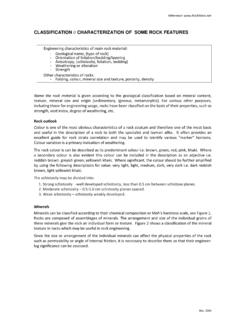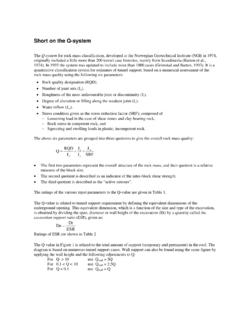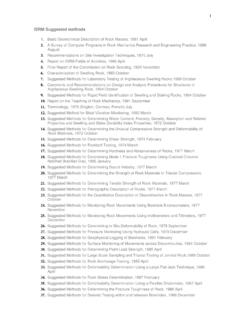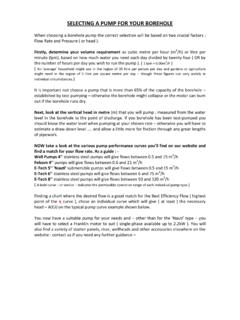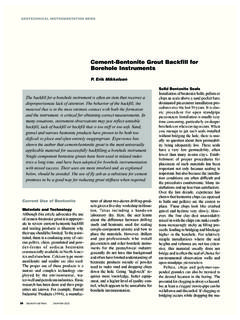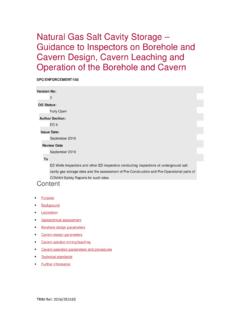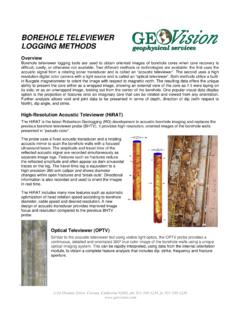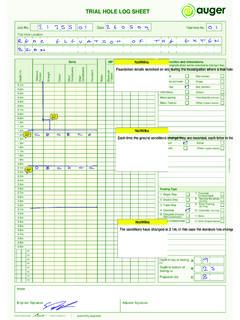Transcription of A guide to core logging for rock engineering - RockMass
1 Proceedings of the Symposium on Exploration for Rock engineering / Johannesburg / November 1976. Page 71 - 86 A guide to core logging for rock engineering core logging Committee of the South Africa Section of The Association of engineering Geologists SUMMARY. A guide for the logging of borehole core for rock engineering purposes is proposed. General acceptance of such a guide ensures that core logs will generally contain meaningful descriptions of the rock mass parameters most significant in rock engineering problems. The use of defined terms and format ensures that any reader of the log will have an appreciation of the original appearance of the core , and in particular those aspects important to rock engineering . The proposed guide takes due cognizance of existing accepted systems of soil and rock mass description or classification and attempts to remain compatible with these wherever feasible.
2 Only those parameters which are commonly of interest in rock engineering are described. Qualitative descriptions depending only on visual inspection and simple mechanical field tests are used. Primary core descriptions include descriptions of colour, weathering, fabric, discontinuity surface spacing, hardness, rock name and stratigraphic horizon. This is followed, where required, by a description of the discontinuity surfaces including their type, separation, fracture filling (presence or absence), roughness and orientation. If significant an additional description of the nature of the fracture filling including moisture, colour, consistency or hardness, soil or rock type and origin is added. The significance of each of these parameters with respect to engineering behaviour is discussed and standard descriptive terms defined.
3 Other information commonly recorded on the borehole log, such as drilling method and size, core recovery, RQD, fracture frequency and standard tests are reviewed and techniques of presentation are suggested. Recommendations are made for the handling and storage of rock cores. Some useful techniques for the logging of core are discussed. 1 INTRODUCTION The purpose of the core logging Committee of the South Africa Section of the Association of engineering Geologists was to prepare a guide for core logging for rock engineering purposes in South Africa. For such a guide to be generally accepted it should fulfil the following requirements: (a) It should be sufficiently detailed to ensure that the resulting core log contains enough information to enable reliable interpretations of geological and rock engineering conditions for most typical engineering structures.
4 (b) It should not be so complex as to render its use impractical or unnecessarily cumbersome. (c) It must take due regard of such standardized procedures as may already exist and, where feasible, incorporate these with a minimum of variations. A guide to core logging for rock engineering 2 Proceedings of the Symposium on Exploration for Rock engineering / Johannesburg / November 1976. Page 71 - 86 A distinction is drawn between the borehole log and the core log. The borehole log includes a description of relevant data applicable to the drilling of the borehole and to the core recovered. It includes information on the drilling machine, tools and materials used, progress, difficulties encountered and tests performed. Part of the borehole log is the core log which is purely a description of the recovered core .
5 It is the core log which is the subject of this paper. A core log cannot be considered in isolation from the borehole log in which it is to be included and the parameters comprising the borehole log are therefore also given brief consideration in this paper. The preparation of a core and borehole log presupposes that an adequate driller's record is available. Preparation and nature of the driller's record is outside the scope of this paper. The complexity of rock, as a variable material subject to fractures and weathering, and its complicated inter-related behaviour with the structures formed in or on it, has resulted in the development of a large variety of descriptive systems for logging cores. These systems vary considerably both in the degree of complexity and nature of the parameters described.
6 Of necessity, the guide proposed by this Committee cannot include for all possible eventualities and in the interest of usability has been kept as simple as possible. Only those parameters which are commonly of interest in rock engineering are described using qualitative descriptions dependent only on visual inspection and simple mechanical field tests. Where a specific investigation requires the description of additional parameters or the use of other specific or more detailed classifications or descriptions of properties, these may be added to the suggested core log. The adoption of the proposed guide ensures that descriptions of the most commonly required rock mass parameters are included in the log in accordance with a set of standard descriptions, the interpretation of which is known to anyone who has available a copy of this paper.
7 2 PROPOSED METHOD OF core logging The purpose of the core log is to enable the person reading the log to visualize the cores (as seen by the compiler of the log) and hence to draw inferences on the likely behaviour of the actual rock mass. Only those parameters which are significant to the rock mass behaviour or which enable correlations between boreholes to be made or give a better understanding of the general geology of the site are recorded. Whenever possible, classifications with five class intervals are adopted since the extremes, middle and two intermediate values of such a group are often self-evident. Class interval limits are defined using visual criteria or simple field tests with equipment commonly carried by the core logger (knife, geological pick, etc.). Many boreholes start in soil or pass through soil strata.
8 Descriptions of these soil horizons form an integral part of the borehole log. An excellent system of soil profiling has been proposed, by Jennings, et al1 which has been widely accepted in Southern Africa. The adoption of a system of core description which is similar and compatible with the soils system would be a tremendous advantage. With such similar compatible systems the logger and reader would not be required to work to a "different set of rules" or terms of reference when comparing the soil and rock of a profile. Unfortunately, the soil profiling system was not developed with rock descriptions in mind, and its simple extension into rock does not produce an adequate rock mass description. It has therefore been necessary to modify and adapt the soil profiling system for its application to rock.
9 The resulting system is compatible with the soil profiling system but varies considerably in detail. A guide to core logging for rock engineering 3 Proceedings of the Symposium on Exploration for Rock engineering / Johannesburg / November 1976. Page 71 - 86 The core description includes not only the description of rock material, but also the discontinuity surfaces2 that occur through it and the fracture2 filling materials. It is recognised that while discontinuity surfaces and their filling are of great importance to rock mass behaviour they are often given a secondary role in the rock core description. A core description comprising three parts is therefore proposed: (1) The primary description is that of the parameters affecting the basic rock mass properties. (2) To supplement the above a description of the discontinuity surfaces may be given.
10 (3) Finally, a description of the fracture filling may be relevant. Depending on the nature of the engineering problem, a decision may be made to describe only (1), the basic rock mass parameters, alternatively two or all three parts of description may be required. The core log should be a factual description of the core . Any interpretation or assessments on the part of the core logger should clearly be distinguished from the factual information. It is recognised that assessments and interpretations are best made when actually looking at the core in its fresh and least disturbed state. The logger of the core is therefore often in a very favourable position to make such assessments and interpretations and to exclude these from the core log is to reduce the value of the log. Such interpretations or assessments should be included in parentheses, following the factual core description.
